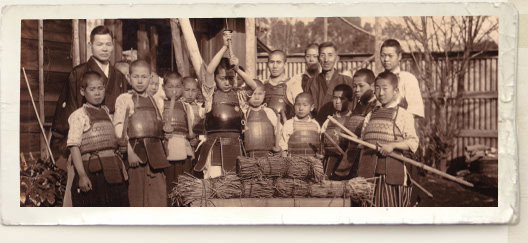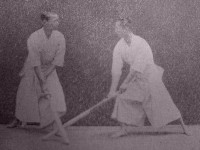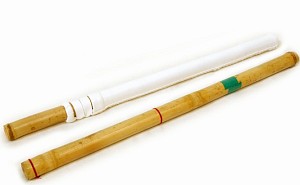
Shinai, Fukuro Shinai
The roots of today’s shinai (竹刀,
shinai) goes back to the Edo era, when it was developed as a training weapon to reduce the number of injured, paralized or even dead students. It was much more safer then bokken made of hard wood. In these times started also in the same reason the development of the bogu in our style.
 The
fukuro shinai (袋竹刀) aka "bamboo sword
with bag" is an important tool of our style. We use it during the
practising of fukuro shinai kata (韜之形) and in other
forms.
The
fukuro shinai (袋竹刀) aka "bamboo sword
with bag" is an important tool of our style. We use it during the
practising of fukuro shinai kata (韜之形) and in other
forms.
In these days the traditional fukuro shinai of Jikishin Kage-ryu Kenjutsu is very rare or even unavailable.
![]()
Jikishin Kage-ryu Fukuro Shinai
As it happens, that Yagyu Shinkage-ryu or other styles use fukuro shinai in their clubs. Usually it can be replaced by shinai (from kendo), which is very similar to it.

Yagyu Shinkage-ryu Fukuro Shinai
There are many sizes and types of shinai. For example, a grown-up man use a quiet heavy shinai, which can be too heavy for women or youngsters.
Shinai

The shinai has four laths (take), which are keeping by four leather strips together; the tsuka-gawa (hilt); the saki-gawa (tip) and the nakayui (a leather strip). These all four elements are fixed by the tsuru (cord)
The laths of the shinai are made of dried bamboo. On occasion it is treated by different methods (fumigation, resin bath) or it is made of reinforced carbon, or rather from other alternative materials.
The nakayui is tied at the one third of the bamboo’s lenght, measured from it’s nib (kensen); This keeps the laths together and in the same time it marks the right surface of the shinai to make proper cutting techniques (datotsu-bu).
Under the saki-gawa, wedged between the end of the laths can be found the plastic inset (saki-gomu). Inside the tsuka-gawa is a small rectangular metal plate (chigiri), which ensures the position of the laths.
The shinai should be well-kept, otherwise it will danger not only it’s user, but the others too. The shinai should be checked for gaps or defects. The conditioning methods must be kept in the prescribed way of the master and the dojo.
Users think if they oiling and burnish the shinai before or regulary during the use, they could increase its lifetime. Still there are controversy even in Japan, which method is the most proper way to keep the shinai in the best condition. But there are even more delusions about different methods.
First of all examine the outskirts of the datatsu-bu to check the shinai properly. Be careful, because defects of the bamboo can easily hurt you. The saki-gawa should be intact and the tsuru tight, so then the saki-gawa will be unable to slide down from the top during usage. Besides the nakayui must be tight too, because of the easy swinging.
If you do not use it, the shinai should be steady downwards with the nib to the wall. It is an intence discourtesy stepping over it, if the shinai is lying on the floor.
